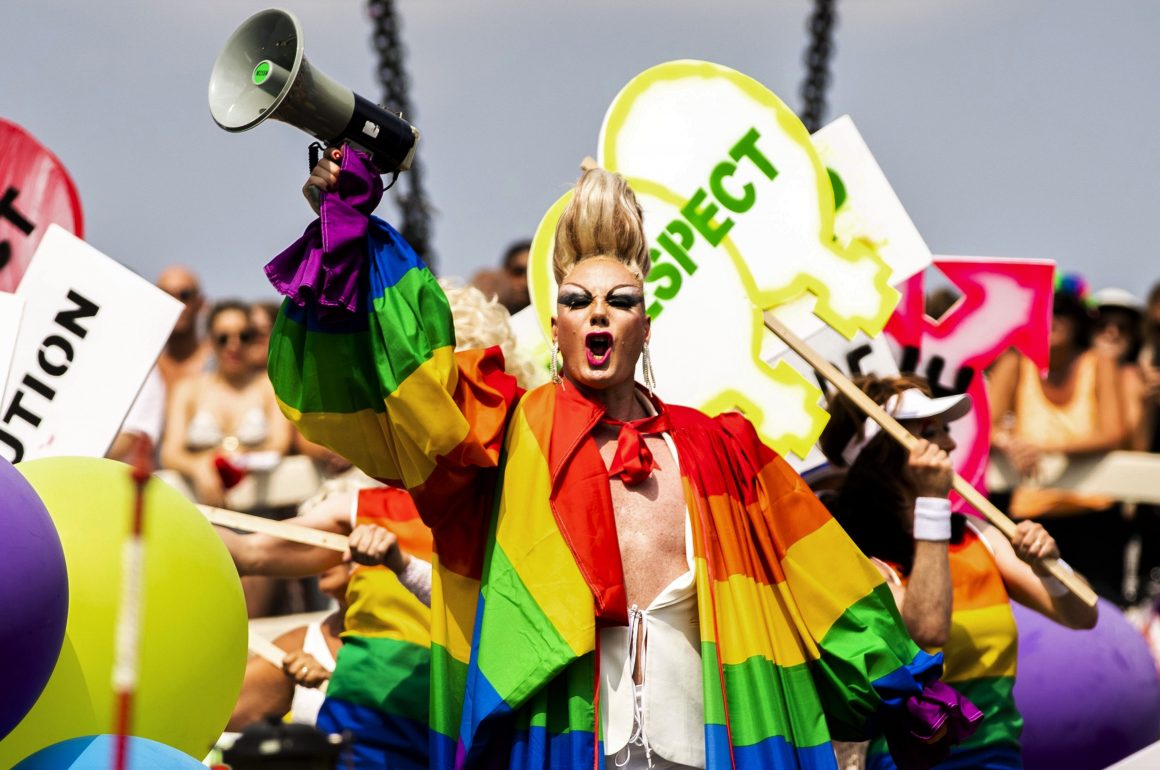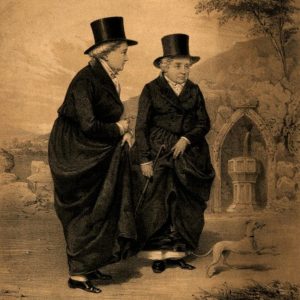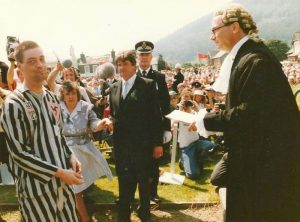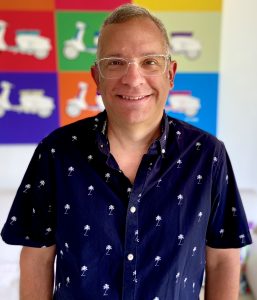
While some terminology for diverse gender and sexual identities may be new, LGBTQ+ people have existed for centuries. The Ancient Celts were no exception. Gayle Gibson of the Royal Ontario Museum wrote on the topic for Xtra magazine back in 2005, and she noted that “the Celts were renowned as much for their erotic energy and multiple love affairs as for their warlike habits. Male warriors were often part of sodalities, groups of ‘special friends,’ who engaged freely and openly in same-sex relationships. Ancient Greeks such as Aristotle and Strabo mention Celtic homosexuality as one of the few good things about what they considered a barbarian culture.” Primary sources on the ancient Celts are few and far-between, but “nonprocreative relationships outside of marriage were also acceptable and legal for men and women,” so it is not unreasonable to conclude that, as with other ancient cultures, same-sex relationships existed between male Celts as well as between female Celts.
Paving the Way
More recent history is a bit more accessible. Although little is known about his life, Patrick McCormack could be the first transgender person recorded in Dublin. Irish History Podcast touched on the topic in 2018. A famine survivor and labourer, McCormack died in 1871, after which it was discovered that he had been assigned female at birth. Then, there are more high-profile examples, such as Irish poet Oscar Wilde – a name synonymous with homosexuality in the Victorian era. However, it is impossible to say how much queer history has been buried or glossed over in general – let alone when we look at the Celtic nations specifically.
“For everything we have done so far on LGBT history, I think it I just the tip of the iceberg,” says Norena Shopland, an LGBTQ+ historian in Wales.
Shopland started her career as an archeologist and hadn’t been especially interested in queer history until she got a job working at The Lesbian and Gay Newsmedia Archive in London. She also participated in the Museum of London’s “Reassessing What We Collect” – a project about lack of diversity in the museum’s collections.
In 2007, after returning to her home country of Wales with her wife, she found that there was nothing being done about Welsh LGBTQ+ history, save “a couple of half-hearted history month” projects. A few years later, Shopland applied for – and received – funding for an exhibition on Welsh LGBTQ+ people, allies and events. With a relatively short time period to prepare the exhibition, Shopland was effectively “starting from scratch” with the research. One difficulty, she notes, is that “Wales is often subsumed into England” – meaning that people such as Ivor Novello or the Ladies of Llangollen were often identified simply as part of British history, or even English history. “We didn’t have a list of anybody, really. So, it was having to put a list together that we could then build the exhibition on.” The work was worth it in the end, as the exhibition was popular with audiences.
Then, in 2017, Shopland published her book Forbidden Lives: LGBT Histories from Wales. The work was the first completely nonfiction book on the queer history of Wales. As LGBTQ+ terminology only dates back to the late 19th century, “I had to stop looking at what people were” in terms of identity, “and I had to look at what people were doing.” Crossdressing, for instance. This method of research helped her find people beyond the well-known or “famous” queer people. “I wanted ordinary, working class people, because working class people are so underrepresented.”

Marged Uch Evans (or Marged ferch Ifan) was a figure who Shopland found particularly fascinating and included her in Forbidden Lives. “The only reason that she is included in the historical record is because she was so masculine.” At that time, “a lot of women would have been masculine as they were doing very heavy work,” such as farm work. “So, when you bear in mind that this woman’s fame is centered around her extreme masculinity, that tells you something.” While it is important not to make definitive claims about her gender or sexual identity, Shopland says the way that Evans is reflected in historical record does raise questions. In addition to her extreme masculinity, Evans was very close to her maid – a fact that was noted during the 18th century, a time when servants were hardly noted about at all. Still, Shopland refrains from calling her a lesbian, as such a term did not exist at the time.
“There was no concept of how we consider a lesbian today, or a gay man today, or trans or bisexual. So, we are in danger of inflicting upon our readers an image of someone from the past that simply didn’t exist. I stick to more neutral terms like sexually fluid, gender fluid, that sort of thing.”
Because of the success of her research, Shopland helped compile an online LGBTQ+ research guide for the Glamorgan Archives. She also published a book called A Practical Guide to Searching LGBTQIA Historical Records. Her upcoming book, A History of Women in Men’s Clothes: From Cross-Dressing to Empowerment, is expected to be released in August.
Keeping in mind that Shopland is limited to English language research and mainly Western historical records, there remains much global LGBTQ+ history still uncovered. “All this horrendous amount of research still needs to be done. And once we do that, it is just going to blow open the floodgates of LGBTQ+ history.”
Progress and Pitfalls
LGBTQ+ identities are much more visible than they once were. But it took time – and some serious advocating for change – to get here.
Activist Alan Shea is one such advocate. Shea challenged the Isle of Man’s criminalization of homosexuality on Tynwald Day (the National Day of the Isle of Man) in 1991. According to tradition, people may present their grievances on this day each year during Tynwald ceremony at St Johns, and so Shea did just that. He wore pyjama jacket and trousers, painted with grey and black stripes. The protest outfit also included a pink triangle with the Isle of Man triskelion on it, as well as the number 626262 – the Isle of Man Government phone number. The attire resembled a Nazi concentration camp uniform, as Shea was drawing parallels between the criminalization of homosexuality and the Nazi persecution of LGBTQ+ folks.
Today, not only has homosexuality been decriminalized, but same-sex marriage is now legal in all of the Celtic nations. Northern Ireland was the last to catch up in January of 2020, after the Northern Ireland (Executive Formation etc.) Act 2019 was amended.
Journalist Lyra McKee famously spoke about what it was like to grow up queer in Northern Ireland during a TEDx Talk:
“Within the LGBT community, we have a saying that we tell people. We tell them that ‘It Gets Better’ – it gets better for some of us; it gets better for those of us who live long enough to see it get better.”
Tragically, McKee was murdered while covering a riot in Derry in 2019.
Sharni and Robyn Edwards-Peoples were the first same-sex couple to get married in Northern Ireland. The pair even posed in front of a mural featuring McKee as part of a photoshoot. At the time of her death, McKee had a girlfriend she hoped to marry. So, Sharni and Robyn’s marriage symbolized something beyond the couple themselves – it marked the beginning of a new era, and one that many had been wishing and fighting for. Some of them, like McKee, never got to see it with their own eyes.
There is no overstating the importance the right to marry has for many. However, other issues of discrimination persist. Transphobia has been on the rise across the United Kingdom in particular, as confirmed in a recent report from the European Region of the International Lesbian, Gay, Bisexual, Trans and Intersex Association (ILGA-Europe). Challenges are especially apparent for transgender youth. As the result of a High Court ruling last year, the only National Health Service clinic for minors in the U.K. stopped referring transgender youth for puberty blockers.
 “Despite evidence that puberty blockers help trans teens feel happier and healthier and improve their mental health outcomes, the court ruled that teens were too young to make long-term decisions about their gender and gender affirming medical care would have to be approved by the courts,” reads a report from Them magazine.
“Despite evidence that puberty blockers help trans teens feel happier and healthier and improve their mental health outcomes, the court ruled that teens were too young to make long-term decisions about their gender and gender affirming medical care would have to be approved by the courts,” reads a report from Them magazine.
Still, activists and advocates persist, as ever. And the more LGBTQ+ people who make themselves known and take up space, the harder it will be to ignore these issues. The proof is in the progress.
Nearly 19 years after Alan Shea stood up for gay rights on Tynwald Day, the Manx Government gave a formal apology for its discriminatory law. Luke Adebiyi, a board member for the Isle of Pride charity, says the Isle of Man has progressed “massively” in terms of LGBTQ+ rights and acceptance. “There is still more to do,” he shares via email, “and I think from an educational perspective, there are more activities that could take place. The Isle of Man truly is so welcoming.”
The Isle of Pride festival, intended to be the first of its kind for the nation, was cancelled last year due to the pandemic. “We will be releasing further details in due course on this year’s activities,” says Adebiyi. “We have huge support from the local community, so we are sure this is going to be a weekend like no other.
“We are very keen not just in the LGBTQ+ space (although this is our primary agenda) but look at the wider diversity activity. We have plans for the future to create safe spaces for members of the LGBTQ+ charity and will look at collaborating off-island for some activities.”
Queer Visibility in Celtic Dance
In Ireland, Breandán de Gallaí – formerly of Riverdance – says there have been major strides in last few decades. For him, though, the journey was a long one. He didn’t tell his parents he was gay until he was 30 years old.
“People might imagine that being part of a dance organization, coming out as a gay man is easy. It wasn’t,” de Gallaí, now 51, shares in an interview.
Currently the artistic director of the Dublin-based Ériu Dance Company, De Gallaí was nudged into Irish dance by his parents at age seven. “I think about it differently now because of the of the opportunities that came with it, but at the time it was extremely difficult,” he says, reflecting on the experience of being a boy in dance. “Kids are cruel, so they will find a reason to pick on you anyway, but it was very much because I was doing dance.”
De Gallaí attended secondary school in the 1980s, which he calls a very conservative time in Ireland.
“It was so oppressive that I didn’t even identify myself privately as a gay person. I didn’t have any gay role models where I grew up.”
During his time at the Gus Giordano Dance Academy in Chicago, de Gallaí did meet men who, upon reflection, he realizes were probably gay. But he wasn’t yet ready for self-exploration. That came much later, while he was touring with Riverdance in his mid-20s.
This led to de Gallaí’s girlfriend breaking up with him, and “I really had to deal with this new direction,” he says. “You might imagine in showbiz, you might find it much, much easier, because everyone in musical theatre is queer. Riverdance wasn’t like that.”

Eventually, de Gallaí met someone on tour, and when Riverdance returned to Ireland, he decided to tell his parents. It went well. “After that, it was easy to take the subsequent steps. The relief is so monumental – you just know people know.”
After leaving Riverdance, his identity “became a central part in what I did. Not just being a gay man, but the sense of being ‘othered’ – no matter what that is – and that deeper sense of authentic identity.” This was exemplified in de Gallaí’s Linger: a duet he choreographed, then performed with fellow gay dancer Nick O’Connell in 2016.
While things have changed for the better, de Gallaí says the ideas of gender roles in Irish dance have persisted. “There is this unquestioned (idea) – girls need to be graceful, and boys need to be strong, so that needs to be addressed.”
Jo Troll, a nonbinary dancer and artist based in the Boston area, says they often come upon people who simply haven’t had conversations about gender or queerness. Some don’t even make the effort, which can become an issue during classes. For instance, a teacher will instruct a particular arm position “for boys” and another position “for girls.”
“When you are met with information that you don’t know how to handle it is just easier to ignore it, most of the time,” says Troll. “That is usually what seems to happen.”
Generally disinterested in competitive or company dancing, Troll choreographs their own dances, and the “building blocks” of their work are rooted in Irish dance.
“I am comfortable moving in certain ways because of training and just who I am, and what my body is, and that is what I want to do. I know that is not what every dancer wants to do, but at this point, that is what I am doing.”
As a teacher themself, Troll says that they are seeing younger folks (who are more used to queer-inclusive spaces) bringing more inclusive energy into dance classes. Recently, when going over introductions with a new set of students, each student shared their pronouns along with their name. “I definitely see things like that. I think I am still waiting to see how that then plays out in other spaces and for the culture as a whole.”
Michiko Bown-Kai notices gendered aspects in the world of Highland dance as well. They are a United Church minister in Ontario, who also happens to have a passion for dancing. Unlike Troll, however, they do participate in competitions.
“In a really competitive, small world, when you are working really hard to do well at competitions and you don’t know exactly how judges might feel about things, I can see how that creates a different sort of pressure to not want to rock the boat in any way,” says Bown-Kai. For them, their hairstyle has to change, and their facial piercings have to be removed based on competitive regulations.
“I would love to be able to compete wearing the ‘men’s outfit,’ but that would ruffle so many feathers.”
In recent years, “the Highland dance community is much more connected online.” In this way, they have been able to connect with other Highland dancers who are “out” as queer. “I also do get messages from people from time-to-time, being like, ‘I am not out yet. I am not sure what that would look like in at my dance studio, or my home, or just the Highland world in general.’”
Similarly, de Gallaí says more Irish dancers are “out” these days. Based on conversations he has had, though, progress is slower when it comes to the traditional music scene.
“The thing about Irish dance organizations is that they are quite liberal in comparison to the Irish music organizations, which is weird.”
Music
“I am always looking for find other gay pipers,” Kevin Loud says over a video call from his home in Florida. “It is like being a unicorn or Bigfoot or something.”
 Loud first picked up the bagpipes when he was living on Long Island, New York. He always had an affinity for the instrument. “I love the way the ground vibrates, and you feel it,” he says. When Loud’s husband signed him up for a free bagpipe lesson at the local Hibernian Hall, his life changed.
Loud first picked up the bagpipes when he was living on Long Island, New York. He always had an affinity for the instrument. “I love the way the ground vibrates, and you feel it,” he says. When Loud’s husband signed him up for a free bagpipe lesson at the local Hibernian Hall, his life changed.
“I was just a nervous wreck going into it,” recalls Loud. “I was so focused on (the other pipers) reacting to me, when a big part of it was me reacting to them, and my own stereotypes of bagpipers.”
In his mind, he had pictured a group of burly men and wasn’t sure how he would fit in. As it turned out, the group included men and woman of various ages.
“I absolutely fell in love with the whole process of learning. It was therapy to go there once a week.”
He eventually became part of the band, playing at parades and events. He doesn’t even really remember how he “came out” to the other band members – it just happened naturally.
“It didn’t matter that I was gay. It just mattered that I was a bagpiper.”
Six years ago, Loud and his husband moved to Fort Lauderdale. There, Loud played in a police band for a time, but he found it wasn’t the right fit for him. He took a break from piping and has since found his way back to it. For now, he calls himself a “backyard piper.” That said, he misses playing in band. He likes to imagine being part of an LGBTQ+ group of pipers “with rainbow kilts, playing traditional songs and not-so-traditional tunes.”
“I know nothing about doing any of that, but I think if there were veterans who knew what to do…to have the Pride Pipers and Drummers would just be fantastic.”
People like Loud might feel like “unicorns,” but they are not necessarily rare. For instance, Celtic folk musicians have formed queer-friendly collectives such as Bogha-frois and Femfolk, challenging the idea of what it means to be a “trad” artist.
Like Loud, Nova Scotian fiddler Ashley MacIsaac finds that most people only care about how he plays. His sexuality is hardly relevant. “Real music fans couldn’t care less about my personal life. They don’t want to hear about my visit to some really awesome dance club in New York’s Gay Village. They want to hear my music,” he wrote in a 2018 piece for Celtic Life International.
Culture Shift
As MacIsaac put it: “The irony of it all is that while the music of the Celts has been around a long time, being gay has been around even longer.”
Hatred and gatekeeping won’t change the fact that LGBTQ+ people exist in all corners of the world, in every vocation. Scholars are even adapting traditional languages, such as Gaelic and Scots language, to be inclusive of queer identities. And, as Norena Shopland pointed out, we have only scratched the surface of queer history.
What about the queer future? With young people coming out every day, we can only hope the artistic and political spheres will continue to move with the times.




















Leave a Comment